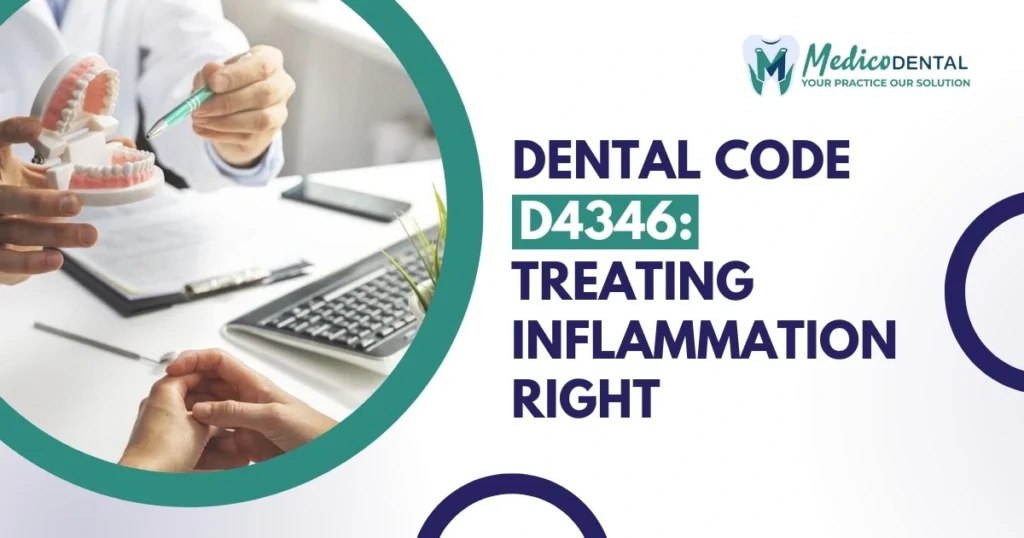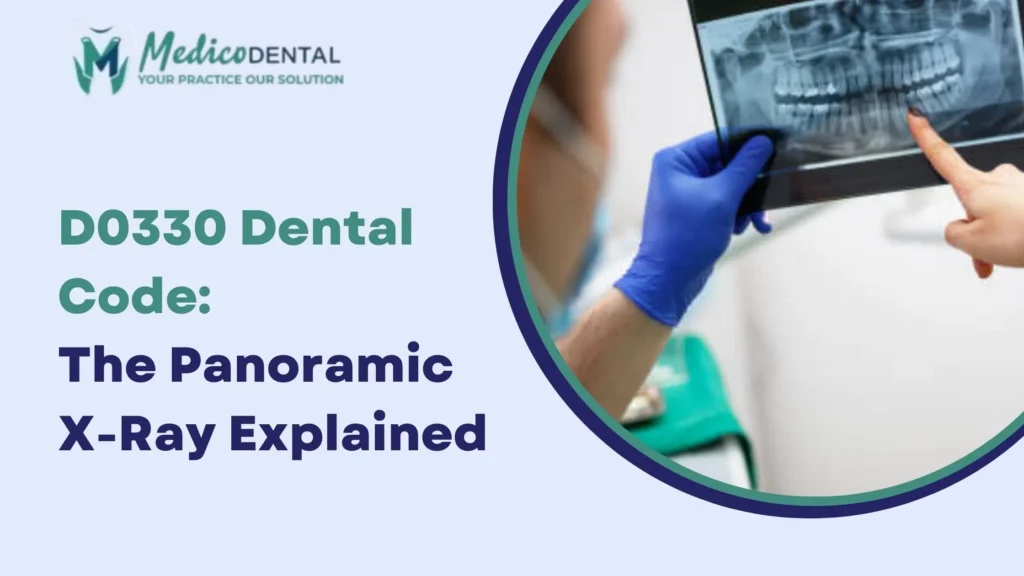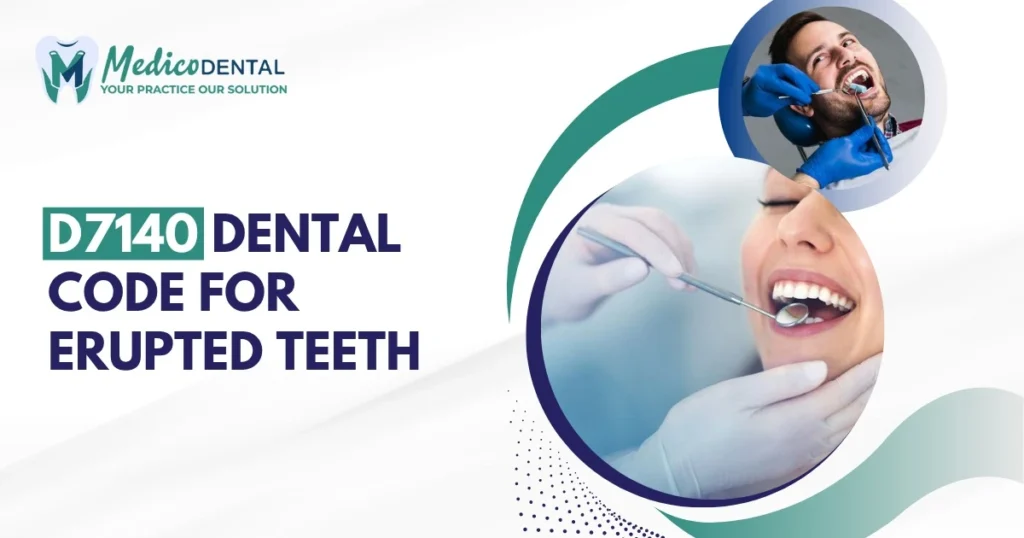Dental Code D4346 was introduced to fill an important gap in dental procedure coding for patients who suffer from generalized gingival inflammation but do not yet show signs of periodontal bone loss. This code acknowledges that some patients need more than a simple cleaning (prophylaxis), yet do not qualify for periodontal therapy. Understanding how, when, and why to use D4346 helps dental professionals deliver accurate treatment and secure appropriate reimbursement.
What Is Dental Code D4346?
Definition and Purpose of D4346
Dental Code D4346 suggests the term of scaling under circumstance of generalized moderate or severe gingival inflammation. It is a fullmouth scaling that targets patients who portray severe gum irritation. throughout the mouth without evidence of attachment loss or bone destruction.
This code recognizes that inflammation, bleeding, and plaque accumulation can make routine prophylaxis insufficient. D4346 allows providers to perform a more extensive cleaning that targets inflamed tissues and removes deposits above and below the gum line. The goal is to reduce inflammation, restore gum health, and prevent progression to periodontal disease.
How It Differs from Other Scaling Codes
D4346 is often misunderstood or confused with other common scaling codes, such as D1110 and D4910. The main difference lies in the patient’s condition and the extent of disease:
D1110 (Prophylaxis)
Used for patients with healthy gums or mild localized gingivitis. It focuses on routine cleaning and maintenance.
D4346
Used when the entire mouth shows moderate to severe gingival inflammation but there’s no bone loss.
D4910 (Periodontal Maintenance)
Used for patients who have already undergone periodontal therapy and require ongoing maintenance.
In short, D4346 bridges the gap between preventive and therapeutic care a crucial middle ground that ensures accurate diagnosis and treatment for inflammatory conditions.
When to Use Dental Code D4346
Clinical Indications and Diagnostic Criteria
D4346 is indicated for patients showing generalized gingival inflammation that affects more than 30% of the mouth. Clinical signs may include redness, swelling, bleeding on probing, and tenderness of the gingiva. Importantly, radiographs and clinical examinations must confirm no attachment or bone loss, distinguishing these patients from those with periodontitis.
Dentists should also look for pseudopocketing, which occurs when inflammation causes gum swelling without actual attachment loss. These cases are ideal for D4346 as the procedure helps control bacterial buildup and supports healing before irreversible damage occurs.
Common Symptoms and Patient Conditions
Patients who qualify for D4346 typically present with:
- Persistent gum bleeding during brushing or flossing
- Puffy, tender, or swollen gums
- Generalized redness and inflammation
- Bad breath caused by plaque and bacteria accumulation
- Mild discomfort during eating or brushing
These symptoms indicate that a routine cleaning will not suffice, as inflammation makes scaling more complex and timeconsuming. D4346 allows providers to bill appropriately for the level of care required.
Step by Step D4346 Procedure Explained
PreTreatment Assessment
Before performing the D4346 procedure, a comprehensive examination is essential. This includes charting the gums, recording bleeding points, and taking radiographs to rule out bone loss. Dental professionals must document all clinical findings such as the presence of generalized inflammation and the absence of attachment loss.
Patient education is equally important. The dentist should explain the difference between this procedure and a regular cleaning, ensuring patients understand why this code is used and how it benefits their gum health.
Scaling and Polishing Process
Once the assessment is complete, the dentist or hygienist performs a fullmouth scaling. This involves removing plaque, calculus, and bacterial deposits from both above and slightly below the gum line. Because the gums are inflamed, this step often takes longer than a standard cleaning.
After scaling, the teeth are polished to remove residual stains and smooth surfaces, helping prevent further plaque buildup. The goal is to reduce inflammation and restore gum health.
PostTreatment Care and Patient Instructions
After the procedure, patients receive personalized oral hygiene instructions. This may include advice on proper brushing and flossing techniques, antimicrobial rinses, and scheduling followup visits to monitor healing.
Dentists should emphasize that inflammation won’t resolve overnight and that consistent home care and professional maintenance are essential for longterm gum health.
Documenting postprocedure recommendations also supports insurance claims and reflects comprehensive patient care.
Documentation and Clinical Requirements for D4346
Proper Charting and Clinical Notes
Accurate documentation is critical when reporting Dental Code D4346. Clinical notes should clearly describe:
- The presence of generalized moderate or severe gingival inflammation
- Absence of clinical attachment or bone loss
- The extent of bleeding, swelling, and other symptoms
- Fullmouth involvement (more than 30% of areas affected)
Supporting records including intraoral photos, periodontal charting, and radiographs strengthen the claim and reduce the risk of insurance denials.
Importance of Accurate Diagnosis
Accurate diagnosis not only ensures appropriate reimbursement but also reflects the quality of care. Misclassifying a D4346 case as a routine cleaning can lead to undertreatment and missed opportunities for early intervention. Conversely, using periodontal codes incorrectly can lead to claim rejections or compliance issues.
By correctly identifying and documenting cases that meet D4346 criteria, dental providers protect both patient health and practice integrity.
Billing and Insurance Coverage for Dental Code D4346
How to Bill D4346 Correctly
Billing Dental Code D4346 correctly requires a clear understanding of its purpose and documentation standards. This code is used only when generalized moderate or severe gingival inflammation is present across the mouth without bone or attachment loss. Before submitting a claim, dental providers should ensure that all clinical findings, radiographs, and charting support this diagnosis.
When billing D4346
- Use the correct CDT code (D4346) with an accurate description such as “Scaling in the presence of generalized moderate or severe gingival inflammation.”
- Attach detailed clinical notes explaining the presence of inflammation and the absence of periodontal bone loss.
- Include diagnostic evidence such as periodontal charting, radiographs, and intraoral photos to justify medical necessity.
- Avoid combining with prophylaxis or periodontal codes on the same date of service, as this can trigger denials.
Clear documentation and supporting evidence are the keys to smooth reimbursement for D4346 procedures.
Common Denial Reasons and Solutions
Despite being a recognized CDT code, claims for D4346 are sometimes denied due to misunderstanding or insufficient documentation. Common denial reasons include:
Lack of clinical evidence:
If the insurance reviewer doesn’t see clear proof of inflammation or the absence of bone loss, the claim may be denied.
Solution: Always submit intraoral photos, probing measurements, and narrative notes describing inflammation and bleeding.
Incorrect code selection
Some offices mistakenly bill D1110 or D4910 when D4346 is appropriate.
Solution: Match the code to the exact clinical condition and confirm no bone loss before billing D4346.
Limited plan coverage
Certain insurance plans may not yet recognize D4346 or categorize it under prophylaxis.
Solution: Contact the payer before submission to confirm coverage or appeal denials with documentation demonstrating clinical need.
Proper preparation minimizes rejections, ensuring the provider is compensated for the work performed.
Insurance Verification Tips
Insurance verification is essential before performing a D4346 procedure. Since coverage can vary among carriers, dental offices should confirm:
- Whether D4346 is listed as a covered benefit in the patient’s plan.
- If there are frequency limitations (e.g., allowed only once every six months or once per year).
- Whether preauthorization or additional documentation is required.
- The patient’s remaining benefits and copayment responsibilities.
By verifying benefits in advance, dental teams can set accurate expectations for patients and prevent payment disputes later. Documenting verification calls or online confirmations also supports dental billing transparency.
Key Differences Between D4346, D1110, and D4910
Prophylaxis vs. Inflammation Scaling vs. Periodontal Maintenance
It’s easy to confuse D4346 with other scaling codes, but each serves a distinct purpose based on the patient’s oral condition:
D1110 Prophylaxis (Adult)
A routine cleaning performed on patients with healthy gums or mild localized gingivitis. It’s preventive in nature and not meant for inflamed tissues.
D4346 Scaling in the Presence of Inflammation
Designed for fullmouth inflammation without bone loss. It requires more time, skill, and instrumentation than prophylaxis but doesn’t reach the level of periodontal therapy.
D4910 Periodontal Maintenance
Reserved for patients who have undergone scaling and root planing or periodontal surgery. It’s part of ongoing management after bone loss has occurred
Each code corresponds to a specific stage of oral health, and using them accurately ensures correct treatment planning, compliance, and reimbursement.
Choosing the Correct Code for Each Case
Choosing between D1110, D4346, and D4910 depends on clinical evaluation. Here’s a simple way to decide:
- If the patient shows minimal or localized gingivitis with no significant inflammation (D1110).
- If the patient exhibits generalized inflammation but radiographs show no bone loss (D4346).
- If the patient has history of periodontal treatment and bone loss (D4910)
Accurate diagnosis not only guides correct coding but also strengthens clinical documentation and ensures ethical billing practices.
RealLife Example of Using Dental Code D4346
Case Study: Treating Generalized Gingival Inflammation
Patient Example: A 42yearold patient visits the dental office complaining of bleeding gums and sensitivity. On examination, the hygienist observes redness, swelling, and bleeding in more than 70% of the mouth. Radiographs confirm no bone loss. The dentist diagnoses generalized severe gingivitis.
Treatment: A fullmouth scaling procedure (D4346) is performed, removing plaque and calculus deposits both above and slightly below the gum line. The patient receives oral hygiene instructions and is scheduled for a followup in four weeks.
Billing: The provider submits D4346 with supporting documentation including chart notes describing inflammation, intraoral photos, and radiographs. The insurance claim is approved because the documentation clearly demonstrates the need for this intermediate procedure.
Outcome: At the followup, the patient’s gums show marked improvement with reduced bleeding and inflammation. The accurate use of D4346 ensures both effective treatment and appropriate reimbursement.
Best Practices for Reporting and Claim Submission
Documentation Tips for Successful Reimbursement
Comprehensive documentation is vital for successful claim submission. When reporting Dental Code D4346, include the following details:
- Detailed narrative explaining the diagnosis, extent of inflammation, and absence of bone loss.
- Fullmouth charting noting bleeding, pocket depth, and tissue appearance.
- Radiographs confirming bone levels are normal.
- Photographs highlighting visible inflammation or bleeding.
Including these details shows that the procedure was medically necessary and performed in accordance with CDT code definitions.
Supporting Evidence and Clinical Photos
Photographs and radiographic evidence play a significant role in claim approvals. Clear intraoral images showing redness, swelling, and bleeding provide undeniable visual proof of gingival inflammation. Likewise, radiographs showing normal bone levels support the exclusion of periodontal disease.
Many dental offices now attach photos and Xrays digitally when submitting claims through electronic systems, reducing the risk of denials and speeding up payment processing. Proper supporting documentation also protects the practice during audits or postpayment reviews.
Conclusion
Correctly applying Dental Code D4346 is essential for both clinical accuracy and financial integrity. This code acknowledges a unique stage of oral disease one that demands more care than routine cleaning but less than periodontal therapy. By identifying and treating generalized gingival inflammation early, dental professionals can help patients restore gum health before permanent damage occurs.
From a billing perspective, precise coding ensures fair reimbursement and compliance with insurance standards. Misuse of codes can lead to denials, underpayments, or compliance risks.
Ultimately, D4346 bridges the gap between preventive and therapeutic dentistry, ensuring that every patient receives care that reflects their true oral condition and that dental practices are properly compensated for their expertise and effort.
FAQs
What is Dental Code D4346?
Ans. Dental Code D4346 is used for full mouth scaling in the presence of generalized moderate or severe gingival inflammation without bone loss.
When should D4346 be used?
Ans. It’s used when over 30% of the mouth shows moderate or severe gum inflammation but no periodontal bone loss.
How does D4346 differ from D1110 and D4910?
Ans, D4346 treats inflammation without bone loss, D1110 is for healthy gums, and D4910 is for post periodontal maintenance.
What symptoms indicate the need for D4346?
Ans. Red, swollen, bleeding gums, tenderness, and persistent inflammation throughout the mouth.
Is Dental Code D4346 covered by insurance?
Ans. Yes, most insurance plans cover D4346, but verification is required since policies vary.



